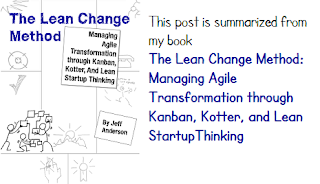Minimum Viable Change
At the first level, we are introducing various change initiatives into the organization. We try to keep these changes small, so that we can learn through on ground adoption as fast as possible. We also want to make sure that these changes represent enough of a change to validate whether we are heading in the right direction for the overall organization. These units of change are called a Minimum Viable Change.
Minimum Viable Changes are validated through a Validated Change Lifecycle. Based on the John Kotter 8 steps of change, the lifecycle promotes a collaborative, cocreative approach to change.

Using this lifecycle:
- a change agent seeks out potential change participants within the organization who can identify
 with the urgency behind instigating some form of change, so much so that they will agree to become a guiding team for that change.
with the urgency behind instigating some form of change, so much so that they will agree to become a guiding team for that change. - change agents and change participants co-create a change by negotiating various constraints such as available commitment and potential benefits
- the change is then validated to see if change participants are able to successfully adopt and adapt to the new working conditions
- Finally, the change is validated to see if improved performance or other outcomes are being realized.
Improvement Experiments
Minimum Viable Changes can be implemented through the lifecycle by decomposing them into a set of Improvement Experiments. Each experiment should only last a couple of days to a week or two maximum.
Each improvement experiment goes through a shorter lifecycle of prepared, introduce, and learn.

Preparation involves just getting ready for the experiment. Workshops need to be scheduled, material needs to be only to be prepared, scheduling needs to take place, etc. The final step of prepare is to rephrase the improvement experiment so that it includes a testable hypothesis.
When we introduce an experiment, we are now working with our chain stakeholders, collaboratively testing our assumptions.
During the learn state, both change agents and change participants assess whether things are heading in the right direction.
The nature of the experiment will vary depending on where a Minimum Viable Change is within the lifecycle. Here are some examples of improvement experiments that could be part of each of the 4 states within the validated chief lifecycle:
- the online team can identify enough problem statements to provide a clear case for the adoption of agile technical practices after 3 facilitated workshops (agree on urgency)
- the portal technology group can articulate and contextualize a more agile working model after 1 week of brainstorming (negotiate change)
- analysts who are part of the International Teller Program Will tell me that they can perform agile style story analysis after 2 weeks of coaching (validated adoption)
- including developers in detail story analysis will reduce defects by 50% after one month (verify performance)
For more check out The Lean Change Method: Managing Agile Transformation Through Kanban, Kotter, And Lean Startup thinking




No comments:
Post a Comment